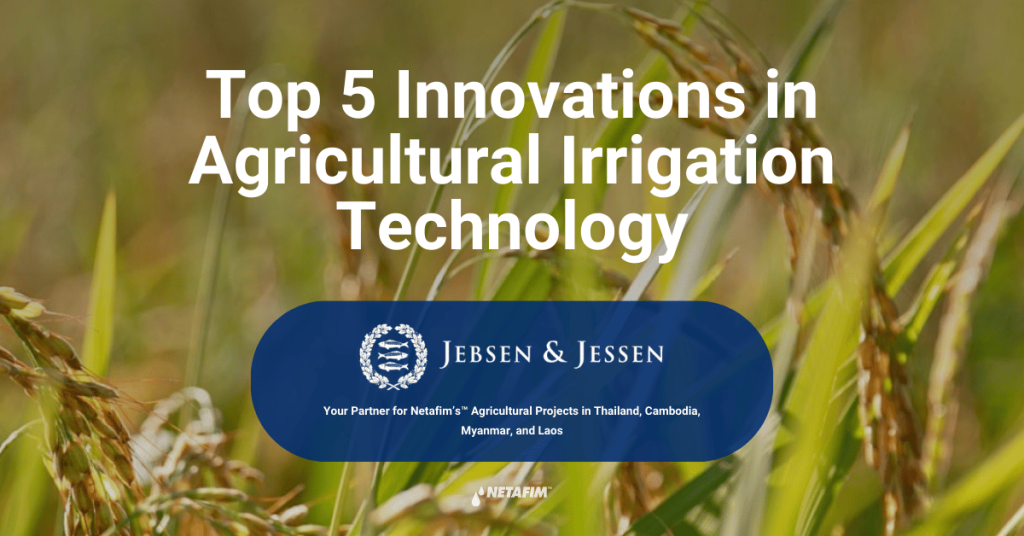Introduction
Due to climate change, urbanization, and increasing water requirements, agriculture is encountering unique challenges today. Farmers must produce more food with reduced water, using sustainable practices. In the outlined context, advanced irrigation technology is essential for urgent concerns. As such, this blog discusses the top five innovations in irrigation technology changing the face of farming practices and examines their benefit in addition to discussing the role played by Jebsen and Jessen (Turf & Irrigation) and Netafim in promoting such technologies in Southeast Asia.
The Importance of Irrigation Technology
Irrigation technology is highly important in most modern agricultural development projects, especially in areas characterized by very scarce water resources. Traditional irrigation approaches like flood and furrow irrigation often involve water wastage and limited crop development. Consequently, employing more advanced irrigation technologies to maximize yields with decreased resource utilization is crucial. Today, the most advanced irrigation technologies help farmers to become more productive, reduce operational costs, and adopt environmentally friendly farming.
Innovation 1: Smart Irrigation Systems
Overview
Internet of Things (IoT) technologies evaluate soil moisture and atmospheric conditions, as well as the health of plants, through sophisticated irrigation systems. Such systems provide agricultural producers with real-time data that helps them decide when to irrigate and how much water to consume.
How Smart Irrigation Works
Most smart irrigation systems have sensors in the ground to measure moisture content, temperatures, and any other environmental factors. Such data are relayed to a central control unit accessible via any smartphone or computer. With this information, farmers can readjust their irrigation schedules, ensuring the crops get the right amount of water.
Benefits
- Agricultural innovation ensures the water supply is according to the latest available data, guaranteeing that plants receive the accurate quantity of water at the appropriate time. This degree of precision prevents overwatering and diminishes any water loss.
- Using these systems with the help of sensors to monitor soil moisture helps farmers avoid applying unnecessary water, thereby enabling substantial savings in water usage.
- The ability to alter water release patterns based on environmental conditions leads to healthier plants and better yields. Consistent moisture levels help roots develop further.
Netafim’s Role
Netafim’s smart irrigation solutions incorporate cutting-edge systems integrating automated platforms and real-time monitoring capabilities. It enables farmers in Thailand to control their watering schedule according to weather conditions and soil types, thus majorly increasing irrigation efficiency. With Netafim’s smart irrigation systems, farmers gain assurance on the productive use of water resources and improved crop yield.
Innovation 2: Drip Irrigation Technology
Overview
Drip irrigation is a technique that allows for direct water supply to the root systems of plants through an interconnected arrangement of tubes, pipes, and emitters. This offers an innovative system to allow precise irrigation, thus reducing water loss and increasing efficiency overall.
How Drip Irrigation Works
In drip irrigation, water spreads through a channel of tubes that runs along crop rows. Periodically, emitters are fitted to deliver water directly into the root zones of individual plants. Such an accurate method ensures that water is given exactly where it is most needed, thus minimizing evaporation or runoff.
Benefits
- Drip irrigation could save up to 60% more water than traditional flood irrigation. This is particularly essential in the case of Thailand, which lacks a proper water supply.
- Drip systems deliver water right to the root zone; evaporation losses become reduced and tolerable for hot climates. It is precisely during such dry spells that crops require special care for survival.
- Consistent moisture content is critical for the development of good roots and for preventing overwatering-related diseases that can threaten the plant. Water-saving irrigation further allows fertilizers and nutrients to be applied directly into the root zone, further stimulating growth in the plant.
Netafim’s Role
Netafim’s drip irrigation systems are developed for various crop types and farming conditions in Southeast Asia. Netafim systems are made to be long-lasting and reliable, thereby reassuring that farmers can gain the best results regardless of the condition. Additionally, with options to customize, Netafim gives farmers the freedom of choice regarding the emitters and layout used in their crops to utilise drip irrigation’s full advantages.
Innovation 3: Solar-Powered Irrigation Pumps
Overview
Solar-powered irrigation pumps provide a sustainable energy solution for farmers, which is especially needed in remote, inaccessible areas. Such pumps convert solar energy into power to run irrigation systems without relying on fossil fuels.
How Solar-Powered Pumps Work
The technology applied in these solar-powered irrigation pumps includes an array of solar panels that convert sunlight directly into electricity, which is then used to power the pump. A pump sucks water from a well or reservoir and distributes it through the irrigation system. This technology is quite helpful in areas where the cost of electricity is high or its supply is unstable.
Benefits
- The solar pump eliminates electricity bills, thereby reducing farmers’ operational costs. This is an advantage, especially for smallholder farmers.
- Using the solar power source, the farmer reduces their footprint on the environment while at the same time making some contributions towards environmental sustainability. Using renewable energy sources also aligns with global efforts to counter climate change.
- Solar-powered water systems are unaffected by fuel price fluctuations and can be applied in remote rural areas. Because they are powered by the sun, the farmer will not depend on anything to operate his irrigation system.
Jebsen and Jessen (Turf & Irrigation) and Netafim’s Role
Jebsen and Jessen (Turf & Irrigation) and Netafim are reaching out to Southeast Asian farmers with much zeal as part of their engagement toward promoting the shift to solar irrigation, bringing more farmers to renewable sources. This results in support for green energy and sustainable farming practices. Jebsen and Jessen (Turf & Irrigation) gives farmers access to solar-powered pumps that they can use to adopt more water-efficient and environmentally friendly irrigation techniques.
Innovation 4: Automated Precision Sprinklers
Overview
Automated precision sprinklers target specific sections of a field based on the varying water needs of those particular areas. They use sensors and timers to ensure proper water delivery with extreme care so as not to waste a single drop.
How Automated Precision Sprinklers Work
These sprinklers include soil moisture sensors and weather monitoring sensors. The system uses the data given by these devices to decide what level of water application is required and when it should be applied in the different sectors of the farm. This way, no crop will receive excess or less water, increasing irrigation system efficiency.
Benefits
- Automated systems can be programmed to adapt to many varieties of crops and their growth stages so that each plant receives the appropriate water amount. It is beneficial for diversifying farming activity.
- Automation limits physical labor very much, which enables the farmer to take care of other aspects of his or her business. The efficiency built in this way might be enormous in saving labor costs in the long term.
- These systems target specific areas, consequently minimizing water wastage and enhancing irrigation’s general effectiveness. Such efficiency is crucial in the maximization of yield in crops while reducing related resource use.
Netafim’s Offerings
Netafim provides precision sprinklers with advanced technology, fulfilling the specific requirements of any farm. Their systems maximize efficiency and ensure the best health conditions for crops. Implementing automated precision sprinkler systems among farms can ensure better water management and crop production.
Innovation 5: Subsurface Irrigation Systems
Overview
Subsurface irrigation refers to directly applying water below the soil surface to the root zone. Such irrigation is much more effective where evaporation rates are very high and in the arid environments.
How Subsurface Irrigation Works
In subsurface irrigation, underground pipes or tubes deliver water directly into the root zone of plants. This way, water is applied where needed most while minimizing losses due to evaporation.
Benefits
- As water is distributed underground, subsurface systems virtually eliminate evaporation loss and are highly efficient. This is important in water-short countries like Thailand, where evaporation can make a big difference.
- The dry surface reduces the growth of weeds, which compete with crops for water and nutrients, limiting crop yield chances.
- Subsurface irrigation provides water in direct locations where it is needed – the most efficient water application under these conditions. This approach is vital to sustainable agriculture practice in areas where serious water scarcity occurs.
Netafim’s Technology
Netafim has designed subsurface irrigation systems to work uniformly across various soil types and climates, making them perfect for various crops. This technology ensures optimal yields with water conservation for the farmers. Subsurface irrigation can help enhance the water management ability of a farmer and will significantly enhance crop health.
Jebsen and Jessen (Turf & Irrigation) and Netafim Partnership
Collaboration Focus
As the official partner of Netafim Agricultural Projects in Thailand, Cambodia, Myanmar, and Laos, Jebsen and Jessen (Turf & Irrigation) has the mission of introducing such innovative technologies to regional farmers, and their partnership aims at offering an innovative irrigation solution by improving efficiency and sustainability.
Regional Impact
Jebsen and Jessen (Turf & Irrigation) plays a very important role in educating farmers of Thailand about these innovations; they offer education and support in implementing these farming technologies. As they offer solutions based on local criteria, farmers can use such advanced irrigation technologies most.
Long-term Vision
Jebsen and Jessen (Turf & Irrigation) and Netafim share similar visions to support the development of sustainable agriculture in Southeast Asia, with a long-term vision that focuses on improving farming efficiency, saving water resources, and increasing crop yields to better respond to growing agricultural sector demands. The result of such cooperation will be the empowerment of farmers to apply innovative irrigation techniques and achieve a more sustainable future.
In Conclusion
The five irrigation innovations discussed in the blog are revolutionizing the face of modern farming. They make it more efficient, contribute to water conservation and produce better crop yields, making them necessary tools for Southeast Asian farmers.
As the agricultural sector continues to evolve, farmers must embrace these innovations. Jebsen and Jessen (Turf & Irrigation) supports you in adopting these cutting-edge technologies and enhancing your farm’s efficiency and sustainability. Contact Jebsen and Jessen (Turf & Irrigation) today to learn more about how Netafim’s products and services can benefit your farming practices and contribute to a more sustainable future for Southeast Asian agriculture.



